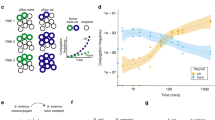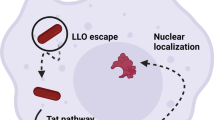Abstract
We provide evidence of direct transfer of functional DNA from bacteria to mammalian cells. An Escherichia coli K12 diaminopimelate auxotroph made invasive by cloning the invasin gene from Yersinia pseudotuberculosis transfers DNA after simple co-incubation, into a variety of mammalian cell lines. Transfer efficiency was enhanced in some cells by coexpression of the gene for listeriolysin from Listeria monocytogenes. Expression of the acquired genes occurs in both dividing and quiescent cells. The only requirement for bacteria to transfer genetic material into nonprofessional phagocytic cells and macrophages is the ability to invade the host cell.
This is a preview of subscription content, access via your institution
Access options
Subscribe to this journal
Receive 12 print issues and online access
$209.00 per year
only $17.42 per issue
Buy this article
- Purchase on Springer Link
- Instant access to full article PDF
Prices may be subject to local taxes which are calculated during checkout
Similar content being viewed by others
References
Trieu-Cuot, P., Carlier, C., Martin, P., and Courvalin, P. 1987. Plasmid transfer by conjugation from Escherichia coli to Gram-positive bacteria. FEMS Microbiol. Lett. 48: 289–294.
Heinemann, J.A. and Sprague, G.F. Jr. 1989. Bacterial conjugative plasmids mobilize DNA transfer between bacteria and yeast. Nature 340: 205–209.
Buchanan-Wollaston, V., Passiatore, J.E., and Cannon, F. 1987. mob and oriT mobilization functions of a bacterial plasmid promote its transfer to plants. Nature 328: 172–175.
Courvalin, P., Goussard, S., and Grillot-Courvalin, C. 1995. Gene transfer from bacteria to mammalian cells. Comptes Rendus Acad. Sci. 318: 1207–1212.
Sizemore, D.R., Branstrom, A.A., and Sadoff, J.C. 1995. Attenuated Shigella as a DNA delivery vehicle for DNA-mediated immunization. Science 270: 299–302.
Sansonetti, P.J., Kopecko, D.J., and Formal, S.B. 1982. Involvement of a plasmid in the invasive ability of Shigella flexneri. Infect. Immun. 35: 852–860.
Sansonetti, P.J., Hale, T.L., Dammin, G.J., Kapfer, C., Collins, H.H. Jr., and Formal, S.B. 1983. Alterations in the pathogenicity of Escherichia coli K-12 after transfer of plasmid and chromosomal genes from Shigella flexneri. Infect. Immun. 39: 1392–1402.
Isberg, R.R. and Falkow, S. 1985. A single genetic locus encoded by Yersinia pseudotuberculosis permits invasion of cultured animal cells by Escherichia coli K-12.Nature 317: 262–264.
Bielecki, J., Youngman, P., Connelly, P., and Portnoy, D.A. 1990. Bacillus subtilis expressing a haemolysin gene from Listeria monocytogenes can grow in mammalian cells. Nature 345: 175–176.
Isberg, R.R., Voorhis, D.L., and Falkow, S. 1987. Identification of invasin: a protein that allows enteric bacteria to penetrate cultured mammalian cells. Cell 50: 769–778.
Cossart, P., Vicente, M.F., Mengaud, J., Baquero, R., Perez-Diaz, J.C., and Berche, P. 1989. Listeriolysin O is essential for virulence of Listeria monocytogenes: direct evidence obtained by gene complementation. Infect. Immun. 57: 3629–3636.
Churchward, G., Belin, D., and Nagamine, Y. 1984. A pSC101-derived plasmid which shows no sequence homology to other commonly used cloning vectors. Gene 31: 165–171.
Isberg, R.R., Swain, A., and Falkow, S. 1988. Analysis of expression and ther-moregulation of the Yersinia pseudotuberculosis inv gene with hybrid proteins. Infect. Immun. 56: 2133–2138.
Isberg, R.R. and Leong, J.M. 1990. Multiple β1 chain integrins are receptors for invasin, a protein that promotes bacterial penetration into mammalian cells. Cell 60: 861–867.
Cormack, B.P., Valdivia, R.H., and Falkow, S. 1996. FACS-optimized mutant of the green fluorescent protein (GFP). Gene 173: 33–38.
Mane, S.M., Marzella, L., Bainton, D.F., Holt, V.K., Cha, Y., Hildreth, J.E. et al. 1989. Purification and characterization of human lysosomal membrane glycoproteins. Arch. Biochem. Biophys. 268: 360–378.
Paglia, P., Girolomoni, G., Robbiati, F., Granucci, F., and Ricciardi-Castagnoli, P. 1993. Immortalized dendritic cell line fully competent in antigen presentation initiates primary T cell responses in vivo. J. Exp. Med. 178: 1893–1901.
Ojcius, D.M., Bravo de Alba, Y., Kanellopoulos, J.M., Hawkins, R.A., Kelly, K.A., Rank, R.G. et al. 1998. Internalization of Chlamydia by dendritic cells and stimulation of Chlamydia specific T cells. J. immunol. 160: 1297–1303.
Steinman, P.M. and Swanson, J. 1995. The endocytic activity of dendritic cells. J. Exp. Med. 182: 283–288.
Schaffner, W. 1980. Direct transfer of cloned genes from bacteria to mammalian cells. Proc. Natl. Acad. Sci. USA 77: 2163–2167.
Heitmann, D. and Lópes-Pila, J.M. 1993. Frequency and conditions of spontaneous plasmid transfer from E. colli to cultured mammalian cells. Biosystems 29: 37–48.
Kovacsovics-Bankowski, M. and Rock, K.L. 1995. A phagosome-to-cytosol pathway for exogenous antigens presented on MHC class I molecules. Science 267: 243.
Sizemore, D.R., Branstrom, A.A., and Sadoff, J.C. 1997. Attenuated bacteria as a DNA delivery vehicle for DNA-mediated immunization. Vaccine 15: 804–807.
Dietrich, G., Bubert, A., Gentschev, I., Sokolovic, Z., Simm, A., Catic, A. et al. 1998. Delivery of antigen-encoding plasmid DNA into the cytosol of macrophages by attenuated suicide Listeria monocytogenes. Nat Biotechnol. 16: 181–185.
Darji, A., Guzman, C.A., Gerstel, B., Wachholz, P., Timmis, K.N., Wehland, J. et al. 1997. Oral somatic transgene vaccination using attenuated S. typhimurium. Cell 91: 765–775.
Sonnhammer, E.L. and Wootton, J.C. 1997. Widespread eukaryotic sequences, highly similar to bacterial DNA polymerase I looking for functions. Curr. Biol. 7: R463–R465.
LaPenta, D., Rubens, C., Chi, E., and Cleary, P.P. 1994. Group A streptococci efficiently invade human respiratory epithelial cells. Proc. Natl. Acad. Sci. USA 91: 12115–12119.
Burns, J.L., Jonas, M., Chi, E.Y., Clark, D.K., Berger, A., and Griffith, A. 1996. Invasion of respiratory epithelial cells by Burkholderia (Pseudomonas) cepacia. Infect. Immun. 64: 4054–4059.
Author information
Authors and Affiliations
Corresponding author
Rights and permissions
About this article
Cite this article
Grillot-Courvalin, C., Goussard, S., Huetz, F. et al. Functional gene transfer from intracellular bacteria to mammalian cells. Nat Biotechnol 16, 862–866 (1998). https://doi.org/10.1038/nbt0998-862
Received:
Accepted:
Published:
Issue Date:
DOI: https://doi.org/10.1038/nbt0998-862
This article is cited by
-
Genetically engineered E. coli invade epithelial cells and transfer their genetic cargo into the cells: an approach to a gene delivery system
Biotechnology Letters (2023)
-
Del-1 enhances therapeutic efficacy of bacterial cancer immunotherapy by blocking recruitment of tumor-infiltrating neutrophils
Clinical and Translational Oncology (2022)
-
War of the microbial world: Acanthamoeba spp. interactions with microorganisms
Folia Microbiologica (2021)
-
Inhibiting avian influenza virus shedding using a novel RNAi antiviral vector technology: proof of concept in an avian cell model
AMB Express (2016)
-
Lactic acid bacteria as mucosal delivery vehicles: a realistic therapeutic option
Applied Microbiology and Biotechnology (2016)



